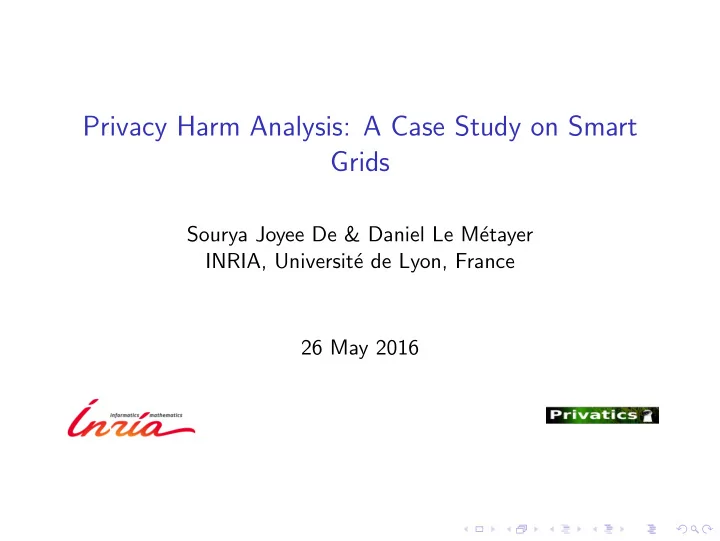

Privacy Harm Analysis: A Case Study on Smart Grids Sourya Joyee De & Daniel Le M´ etayer INRIA, Universit´ e de Lyon, France 26 May 2016
PIA/ PRA is relevant today PIA: “a process whereby the potential impacts and implica- tions of proposals that involve potential privacy-invasiveness are surfaced and examined” (Clarke’98) ◮ Privacy Impact Assessments (PIA) tend to focus more on organizational aspects than technical details - PIA = Privacy Risk Analysis + organizational aspects . . . ◮ DPIA for smart grids by SGTF lacks in clarity in assessing impacts on data subjects, examples Article 33 of the EU Regulation mandates data controllers to carry out PIA.
A true Privacy Risk Analysis (PRA) considers harms Privacy Risk Analysis (PRA) � = Traditional Security Analysis Privacy Harms , = ( Severity ) Risk Level Likelihood Intensity Victims Harm Trees
It also considers technical ingredients ◮ Privacy weaknesses ◮ Risk Sources ◮ Feared Events
But . . . Computer scientists hardly talk about privacy harms. Legal scholars hardly talk about feared events, risk sources or privacy weaknesses.
So, what did we do? We talk about all the ingredients and describe the relationship among them.
Harm trees are central to a PRA PrivacyHarms FearedEvents HarmTrees RiskSources PrivacyWeaknesses
Why smart grids? Information revealed by smart Harms Pattern Granularity meters High/ low power usage during Burglary, profile When are you usually away Hour/ the day based discrimination from home? minute High/ low power usage during Have you been away from home Burglary Day/ hour the day for some time? Burglary, kidnapping, Is your home protected by an Appliance activity matching Minute/ stalking, profile electronic alarm system? alarm system signature second based discrimination Do you stay at home all day Appliance activity matching Profile based Hour/ watching TV or in front of the signature of TV, computer discrimination minute computer? Profile based High/ low power events around Do you cook often or prefer to Hour/ discrimination, meal times for microwave, cook eat outside? minute targeted advertising tops etc. Table: Information Revealed by Smart Meters and Resulting Privacy Harms
What are privacy harms? Negative impacts on a data subject, or a group of data subjects, or the society. ◮ Effects on physical, mental, financial well-being or reputation, dignity etc. ◮ Useful inputs to establish a list of harms are: - previous privacy breaches, case law, recommendations, stakeholder consultation
Severity Code Harm H.1 Profile-based discrimination Maximum Burglary H.2 Limited H.3 Restriction of energy usage Maximum Kidnapping of a child Significant H.4 Table: Examples of harms and their severity values in a smart grid system Profile-based discrimination includes increase/decrease in insurance premium, less favourable commercial conditions, reflection on job or loan applications etc.
What are privacy weaknesses? A weakness in the data protection mechanisms of a system or lack thereof. ◮ Can be found out from a description of existing legal, organizational and technical controls ◮ Privacy weaknesses due to choices of functionalities, design, implementation of the system
Privacy weaknesses Code Security vulnerabilities in Meter Data Management System V.1 V.2 Unencrypted energy consumption data processing Unencrypted transmission of energy consumption data V.3 from home appliances to smart meter V.4 Non-enforcement of data minimization No opt-outs for consumers for high volume/precision data V.5 collection Insufficient system audit V.6 Table: Some relevant privacy weaknesses in a smart grid system
What are risk sources? An entity whose actions lead to privacy harms. ◮ Often referred to as adversary or attacker in the literature. ◮ Examples: system administrators, the utility provider, consumers, service technicians, operators or other employees, hackers.
What are feared events? Occurs as a result of the exploitation of one or more privacy weaknesses. ◮ Technical event between privacy weaknesses and harms
Code Feared events FE.1 Excessive collection of energy consumption data Use of energy consumption data for unauthorized FE.2 purpose(s) Unauthorized access to energy consumption data FE.3 Table: Some relevant feared events in a smart grid system
Harm trees link them all Harm trees depict the relationship among risk sources, privacy weaknesses, feared events and harms. Profile-based discrimination H.1 AND FE.1 OR AND FE.3 FE.2 . . . V.4 V.5 V.6 OR (R3) OR V.1 V.2 V.3 V.6 . . . . . . Figure: Harm tree for profile-based discrimination (H.1)
Risk likelihood is computed using harm trees Profile-based discrimination H.1 (L) AND (R1) FE.1 (I) OR (R3) AND (R1) FE.3 (M) FE.2 (M) . . . V.4 V.5 V.6 OR (R3) OR (R3) (S) (S) (M) V.1 V.2 V.3 V.6 . . . . . . (S) (S) (S) (M) Figure: Example computation of likelihood of profile-based discrimination (H.4) using harm trees Input and output likelihood (probability) values ( p ): P i is the likelihood of i th child node: Negligible (N) : p ≤ 0 . 01% R1: AND with independent children: � i P i . Limited (L) : 0 . 01% < p ≤ 0 . 1% R2: AND with dependent children: Min i ( P i ). Intermediate (I) : 0 . 1% < p ≤ 1% R3: OR with independent children: 1 − � i (1 − P i ). Significant (S) : 1% < p ≤ 10% R4: OR with children excluding one another: � i P i . Maximum (M) : p > 10%
Which harms are the riskiest? Risk level for profile-based discrimination = (Maximum, Limited) Risk level for burglary = (Limited, Negligible) Based on the risk levels, risk due to profile-based discrimination should be primary target for mitigation. This conclusion depends on initial assumptions.
What else can be said? Comparison of harm trees indicate which privacy weaknesses should be mitigated first. Harm trees indicate the effect of a set of counter-measures on the risk likelihood. The process ensures accountability by keeping track of all assumptions and choices made.
Thank you! Contact: sourya-joyee.de@inria.fr, daniel.le-metayer@inria.fr
Recommend
More recommend